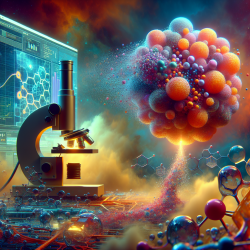Revolutionizing Therapeutic Approaches: Insights from PIPAC Research
In the ever-evolving field of therapeutic interventions, Pressurized Intra-Peritoneal Aerosol Chemotherapy (PIPAC) stands out as a groundbreaking technique, particularly in treating peritoneal metastasis. Recent research, as detailed in the study "Particle stability and structure on the peritoneal surface in pressurized intra-peritoneal aerosol chemotherapy (PIPAC) analysed by electron microscopy," unveils new insights that can significantly impact therapeutic outcomes.
Understanding the Nanofilm Phenomenon
The study highlights a pivotal discovery: the formation of a nanofilm on the peritoneal surface during PIPAC application. This nanofilm, approximately 200 nm in height, forms when aerosol particles, such as doxycycline, collide with the peritoneal surface. Unlike traditional liquid chemotherapy, which struggles with uniform distribution and penetration, the nanofilm offers a promising alternative by enhancing drug delivery and concentration at the target site.
Implications for Practitioners
For practitioners, this discovery opens up new avenues for optimizing therapeutic strategies. Here’s how you can leverage these insights:
- Enhanced Drug Delivery: The nanofilm facilitates a higher concentration gradient, potentially improving drug diffusion and efficacy. Consider integrating PIPAC with nanofilm-forming agents to maximize therapeutic outcomes.
- Customized Treatment Protocols: By understanding the behavior of aerosol particles, practitioners can tailor treatment protocols to enhance drug penetration and minimize side effects.
- Further Research Opportunities: The study calls for additional research into the interaction of complex particles with the peritoneal surface. Engaging in such research can lead to innovative therapeutic solutions and improved patient care.
Future Directions
While the current findings are promising, they also highlight the need for further exploration. Future studies should focus on:
- Investigating the long-term effects of nanofilm on peritoneal tissues.
- Exploring the potential of combining PIPAC with other therapeutic modalities for synergistic effects.
- Developing advanced imaging techniques to better visualize and understand particle interactions at the microscopic level.
Conclusion
The insights from this study not only enhance our understanding of PIPAC but also pave the way for more effective and personalized therapeutic approaches. By embracing these findings, practitioners can significantly improve patient outcomes and contribute to the advancement of therapeutic science.
To read the original research paper, please follow this link: Particle stability and structure on the peritoneal surface in pressurized intra-peritoneal aerosol chemotherapy (PIPAC) analysed by electron microscopy: First evidence of a new physical concept for PIPAC.










